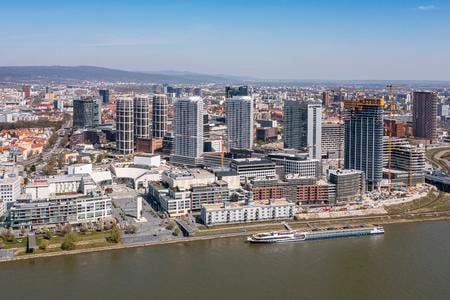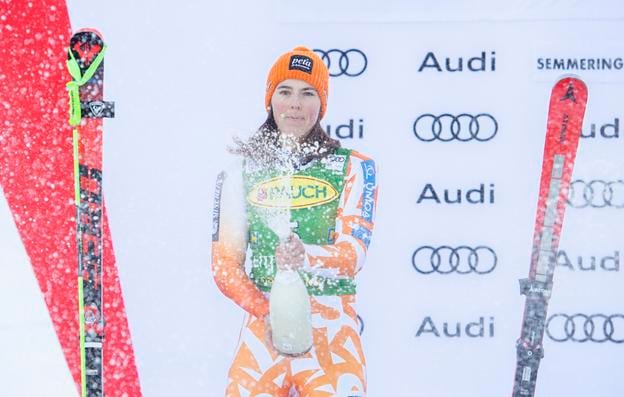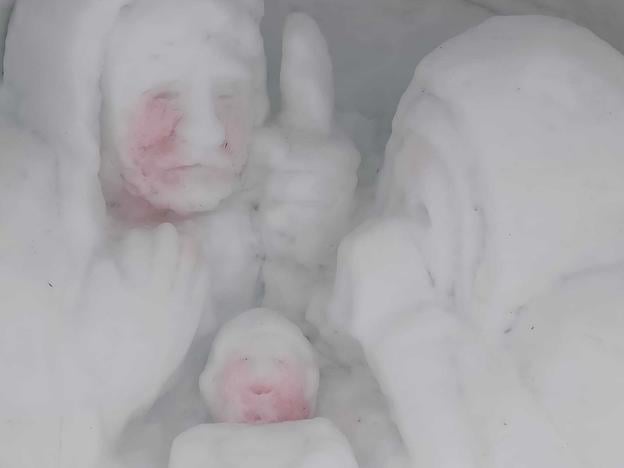Good evening. Here is the Tuesday, December 27 edition of Today in Slovakia - the main news of the day in under five minutes.
Bratislava may have one of the tallest skyscrapers in Europe
The 168-metre first skyscraper being constructed in Slovakia within the Eurovea zone in Bratislava might not keep its record for long. Its developer, J&T Real Estate, is just re-designing its East Tower project at the zone’s edge. It is pondering the replacement of the office tower with a 250-metre high residential tower. By a large margin, it would be the tallest building in Slovakia. It would rank fourth in the EU, the Index of the Sme daily reported.
The East Tower project consisting of a 26-floor office tower and a congress centre, to be constructed at the site of the former Versus printing house at the intersection of Košická and Pribinova Streets, dates back to 2019. The developer had submitted its intention for an environmental impact assessment.
Initially, the developer wanted to start construction work in 2022. But it seems that it will not launch the work anytime soon. Although the developer has a valid development permit, it is trying to redraw the project. It is now pondering the construction of a slender skyscraper at the site. It significantly exceeds the first Slovak skyscraper Eurovea Tower, which with a height of 168 metres, is the tallest building in Slovakia based on the latest international criteria.
“At the site of the East Tower project, we are examining other possibilities of making the most of the valuable territory of the rapidly developing modern centre of Bratislava,” JTRE spokesperson Daniel Suchý told Index. “The alternative shown in the Eurovea City physical model, in terms of the intensity of the development and the traffic load, falls within the intent of the valid development permit. At the same time, it creates more spacious public spaces.”
Other news
Slovakia has received the first €40 million from the European Peace Facility (EPF) for the military assistance it has provided to Ukraine, Defence Minister Jaroslav Naď (OĽaNO) told the TASR newswire. He adds that the country should receive a further €40 million at the turn of the year. Since the start of the Russian invasion of Ukraine, Slovakia has donated aid to Kyiv amounting to €168 million.
This year’s Christmas Eve was the warmest, with the Bratislava Airport meteorological station measuring an air temperature of 14.1 degrees Celsius, the Slovak Hydrometeorological Office (SHMÚ) reported on Facebook. The maximum day temperature record was particularly broken in southwest Slovakia. For instance, the temperature rose to 14 degrees Celsius in Hurbanovo, whereas the previous 2009 record stood at 13.1 degrees Celsius. A new record was also set at the Bratislava Airport. Meteorologists measured 14.1 degrees Celsius, whereas in 2014 it was “only” 13.9 degrees Celsius.
Paramedics went out on 1,766 calls on this year’s Christmas Eve, the highest figure in recent years, Emergency Medical Service Operation Centre spokesperson Alena Krčová told the TASR newswire on Sunday, December 25. For comparison, during last year’s Christmas Eve, the paramedics went out on 1,485 calls in all Slovakia, and on 1,649 calls in 2020. Most patients needed first aid in the Košice region (320). “One oddity was that, unlike in previous years, in 2022 there were cases of patients who had a fish bone stuck in their throats,” said Krčová, adding that three men had bones stuck in such a misfortunate location that they found breathing difficult and had to be rushed to hospitals.
The University Hospital in Bratislava treated more than 380 patients on Christmas’s Eve. Most often they had digestive problems. Hospital workers also treated a patient who swallowed a champagne stopper by chance.
One of the largest suppliers to the automotive industry, the German company Webasto is expected to soon commence the production of batteries for electric cars in Lozorno, close to the Volkswagen Slovakia plant in Bratislava, the Hospodárske Noviny economic daily has found out. The battery factory should open its operation in 2024. It is not clear yet for what models of the VW group it will produce batteries. Several sources told HN that they were not supposed to be for the Superb and Passat models. Instead, it should be an SUV - the flagships of both Volkswagen and Audi.
Slovak skier Petra Vlhová took second place in Tuesday's World Cup giant slalom in Semmering, Austria. With a lead of 13 hundredths, Mikaela Shiffrin won the contest. The leader in the discipline rating, Marta Bassin from Italy, finished in third place (+0.31 sec).
If you like what we are doing and want to support good journalism, buy our online subscription. Thank you.
Feature story for today
Bratislava as a capital city: Transformed skyline, but iconic buildings lost
When Czechoslovakia split into two republics on January 1, 1993, Bratislava found itself the capital of an independent state. However, there was little in its physical structures to reflect its new status. The public authorities had taken a “lukewarm” approach to the city’s new function as a capital, says architecture historian Henrieta Moravčíková.
“There was no intensification in the construction of public buildings or of any new offices or any representative structures related to the city’s status as the capital of the republic,” she explains in an interview with The Slovak Spectator. However, becoming the country’s capital – and the economic transition Slovakia was going through following the fall of the communist regime a few years earlier – proved attractive to private investors.

More stories onSpectator.sk:
Language: Thirty years after divorcing, Czechs and Slovaks still understand each other without hesitation, says popular Slovak linguist Sibyla Mislovičová in an interview.
Culture: The refurbished Slovak National Gallery gears up for re-opening.
Philately: Martin Vančo, head of POFIS, Slovenská Pošta's philately service, discusses the rare technology Slovak engravers use, and reveals why stamp collecting is no longer popular among young people.
Bratislava: Hop on one of the two Christmas trams that run until early January.
Picture of the day
A nativity scene made of snow, which had been standing at Rainer’s Cottage in the High Tatras for several days, was damaged on Monday, December 26. Peter Petras, administrator of the cottage, announced on Facebook that somebody had poured red wine on the sculptures of Mary, Joseph and Jesus. He has already partly repaired the nativity scene.
Petras and accompanying volunteers took 25 days to build the nativity scene. He made his first nativity scene out of snow in 1998.
If you have suggestions on how this news overview can be improved, you can reach us at editorial@spectator.sk.



 (source: SME.sk / Hej,ty)
(source: SME.sk / Hej,ty)
 Petra Vlhová splashes champagne on the podium after the women's giant slalom race of the Alpine Ski World Cup in Semmering, Austria, Tuesday, December 27. (source: TASR)
Petra Vlhová splashes champagne on the podium after the women's giant slalom race of the Alpine Ski World Cup in Semmering, Austria, Tuesday, December 27. (source: TASR)
 The nativity scene damaged by a somebody who poured red wine on it. (source: FB Peter Petras)
The nativity scene damaged by a somebody who poured red wine on it. (source: FB Peter Petras)